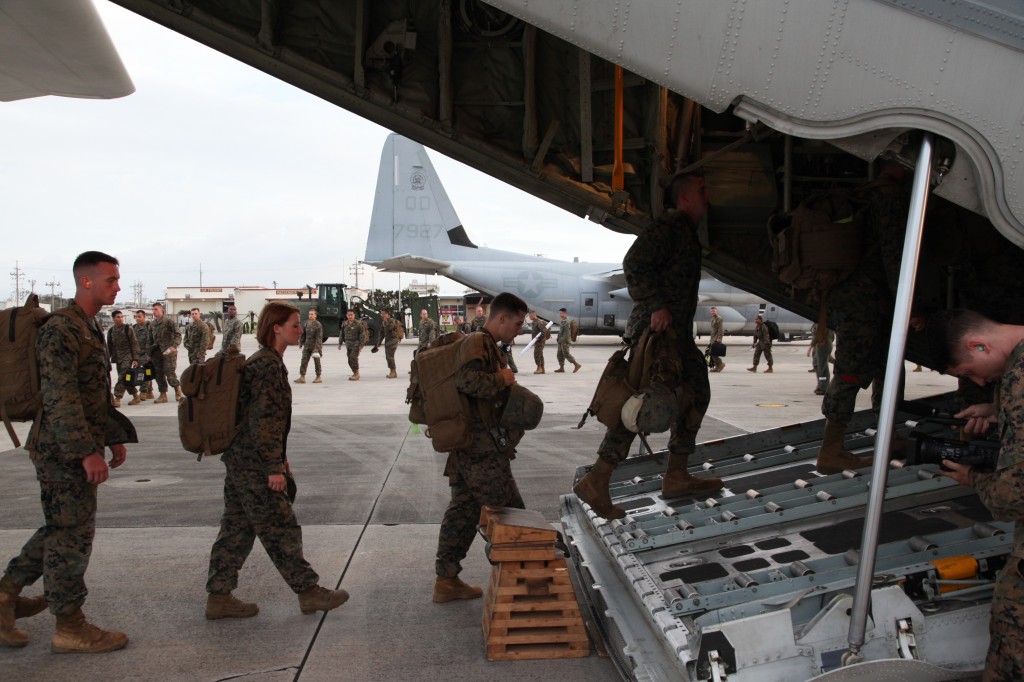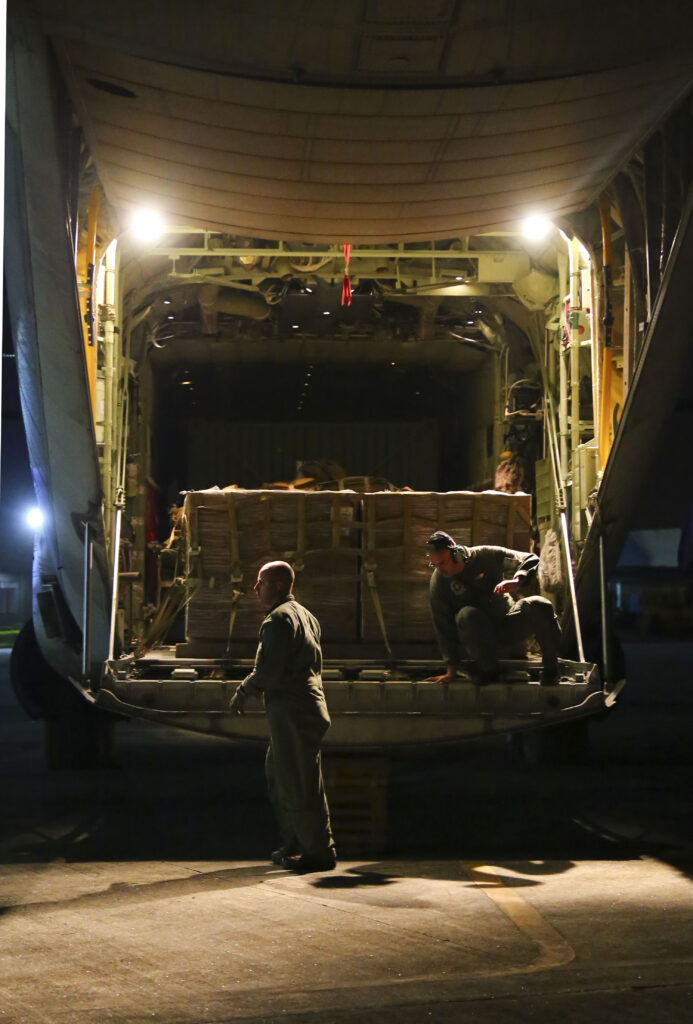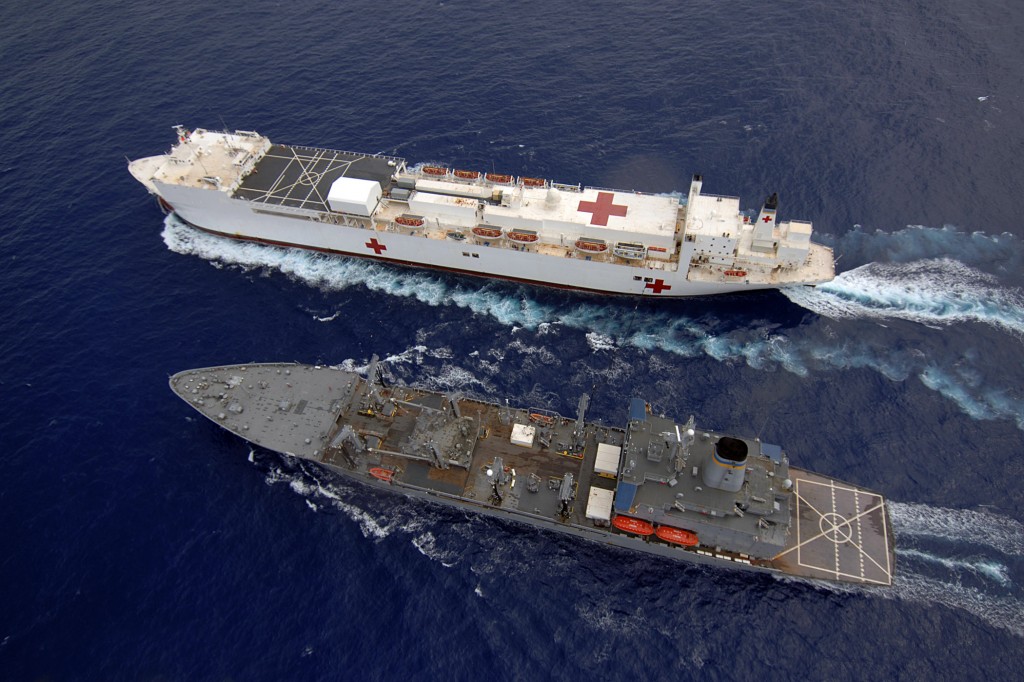Philippine Typhoon Showcases US Strategic Edge Over China
Posted on

US Marines board aircraft bound for the Philippines to help with disaster relief after Typhoon Haiyan.
UPDATE: Aircraft carrier USS George Washington underway to disaster zone.
It is more than a little ghoulish to look at a tragedy that may have killed 10,000 people and see a strategic opportunity. But that’s how strategists have to think. After all, what is war itself but human tragedy exploited for strategic advantage? And that’s how we need to think about what’s happening in the aftermath of Typhoon Haiyan, where US Marines are already on the ground.
[Updated: The Pentagon announced at 5:40 today that the aircraft carrier USS George Washington and its escorts have received orders to “to make best speed” for the Philippines and “should be on station within 48-72 hours.” Marine Corps Forces Pacific said earlier that the US has so far deployed 215 military personnel to Filipino territory.]
The US military is already helping the storm-ravaged Philippines, a long-time ally. The Chinese military not only isn’t responding, it can’t respond — not with anything like the speed or scale that the US can achieve thanks to our global fleet of airborne tankers, cargo planes (like the KC-130Js pictured above), large-capacity naval vessels, friendly seaports such as Singapore, and Pacific land bases. What’s more, the Philippine government probably wouldn’t want help from the Chinese even if they could get there. Those facts represent a major US advantage not only in this one incident in the Philippines but in the long-term struggle for influence across the Western Pacific.
On Saturday, Defense Secretary Chuck Hagel announced he had ordered Pacific Command (PACOM) to assist the Filipinos. In fact, the Pentagon’s chief spokesman, George Little, had already made clear to the media the US stood ready to help in a statement Saturday, and PACOM was probably planning well before. In fact, the US military has been carrying out disaster response operations around the region for years, with the Boxing Day Tsunami the best and most impressive example.

Marines unload Meals Ready To Eat (MREs) at a Philippine air base.
The Chinese response? I can’t find much. Independent media reports a $100,000 or $200,000 cash donation, but the official Xinhua news/propaganda agency’s coverage doesn’t mention any Chinese assistance to the Philippines, while today’s lead stories on the Ministry of Defense website focus on joint counter-terrorism training with India (the India-China-US triangle is its own complex strategic mess) and on how the People’s Liberation Army responded to this summer’s earthquake in the Chinese province of Gansu. China has some capacity – and tremendous need – to respond to domestic disasters, but its ability to project power beyond its own borders remains painfully limited.
It’s not that they’re not trying. The Chinese navy has its own hospital ships, it has conducted humanitarian operations around the region, and it has successfully evacuated its citizens from crisis zones as far away as Lebanon. It’s even refurbishing an old Soviet aircraft carrier for long-range operations. But China’s naval power remains dependent on diesel submarines, on sea mines, and on aircraft and anti-ship missiles launched from fighters and the Chinese mainland. That combo is useless for sending humanitarian aid — or invasion forces — to other countries in the region.
The US Navy, however, is all about influencing events on land. It hasn’t fought a major fleet vs. fleet engagement since World War II, but it has tremendous capacity to project force and to send stuff ashore, whether that’s Tomahawk cruise missiles, Marines, relief supplies, or rescue helicopters. Underlying this advantage is the Pentagon’s unparalleled system of global command and logistics networks to coordinate and supply operations around the world. The first wave of response is often airborne, as shown in the pictures above. But for the really heavy hauling, you need the ships, aircraft, and people of what’s called the “Gator Navy” — something no other nation has.
The Gator Navy comprises 30 amphibious warfare ships [update: two of which are headed for the Philippines] designed to carry Marine Corps forces: troops, tanks, and supplies; helicopters, V-22 tilt-rotors, and hovercraft to get Marines and their gear ashore in a hurry; and even Marine Corps fighter jets for close air support. The largest of those ships, at 40 to 50,000 tons displacement, are what the US calls its nine “big-deck amphibs.” Any other navy would call them an aircraft carrier, but the US Navy disdains to use that term for anything smaller than its ten 100,000-ton nuclear-powered behemoths. The Navy is now building massive new “Mobile Landing Platform” and “Afloat Forward Staging Base” ships to move even more supplies ashore without needing to use a port. We also have the two famous hospital ships, Comfort and Mercy. This force was primarily bought and built to deploy combat troops to hostile shores, the kind of amphibious warfare that’s been a Marine Corps specialty since before World War II. In fact, the current fleet of 30 amphibs is considered not enough to meet the Marines’ requirements for a major conflict. But it’s plenty to deliver supplies and personnel to a coastal disaster zone.

The US hospital ship Mercy gets resupplied at sea.
This kind of help is hardly guaranteed to win hearts and minds. The US provided major assistance to Pakistan after the 2010 floods there, and the Pakistani view of America remains, to put it as politely as possible, complex. But disaster relief can reinforce existing alliances, as in the Philippines today and in Japan in 2011, and it can alter relationships with countries that are ambivalent about the US, as in Indonesia after the 2004 tsunami.
Meanwhile, China’s main actions in the region the last few years have simply antagonized its Western Pacific neighbors with aggressive naval maneuvers and extravagant territorial claims to disputed islands. The $200,000 in disaster aid China has reportedly offered the Filipinos won’t do much to make up for those provocations. (By comparison, Beijing donated $1 million to the Philippines after a 2011 storm, still a fraction of Western aid, but that was before their relations with Manila got really bad). A Chinese navy hospital ship pulling up to the ravaged coastline would do a lot more for China’s regional reputation. But even if China had the amphibious ships to get its own marines to the disaster zone, the suspicious Filipinos probably wouldn’t let them in.
Updated 5:45 pm with details on ongoing US response.
Subscribe to our newsletter
Promotions, new products and sales. Directly to your inbox.
